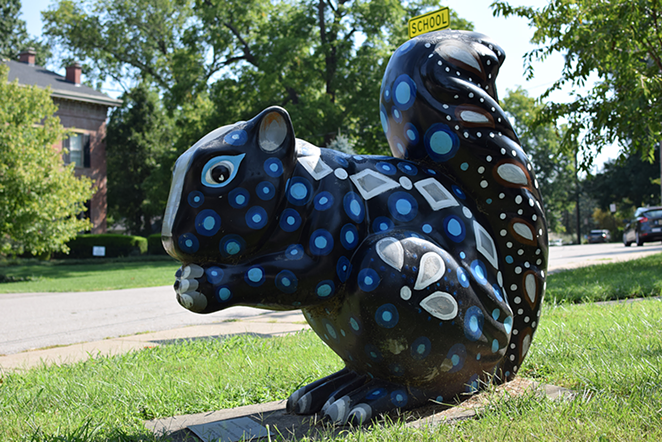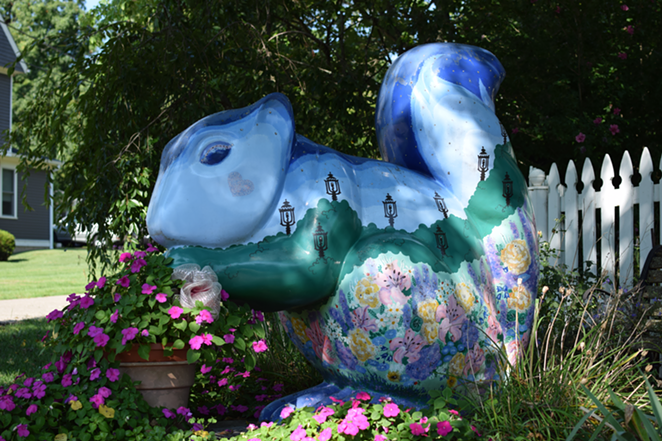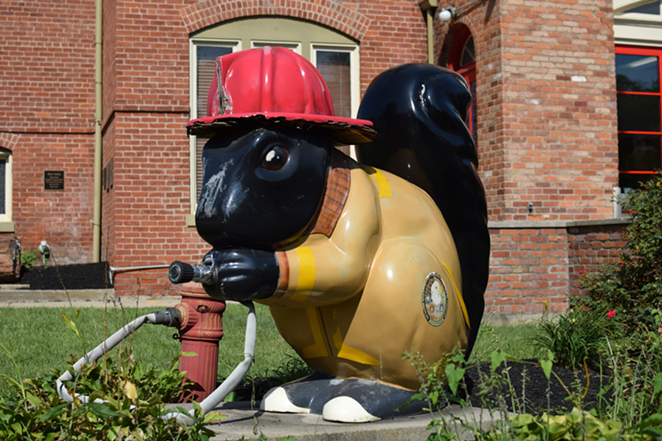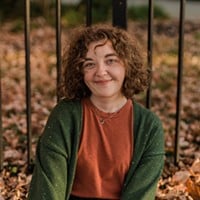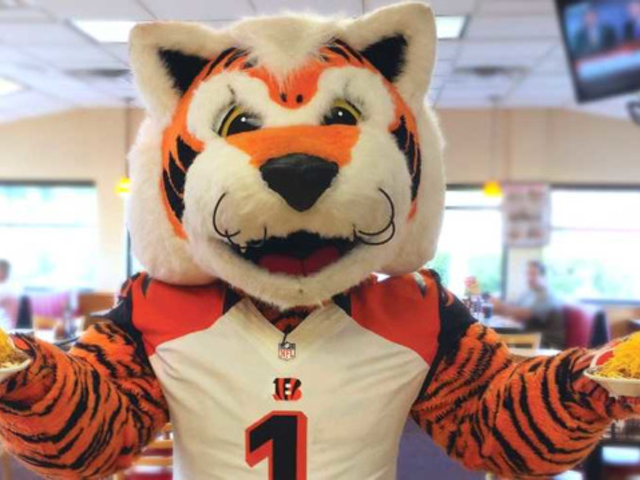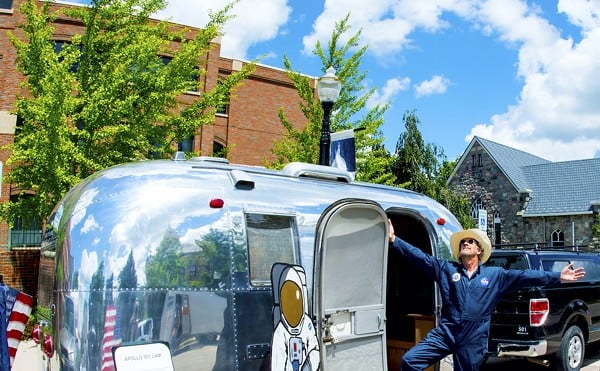Stroll through the Cincinnati suburb of Glendale, and you might notice its rambunctious mascot scurrying up trees or across lawns. And we’re not talking about a human in a costume; the black squirrel, a color morph of the species Sciurus carolinensis, aka the eastern gray squirrel, is a unique inhabitant of the village.
As the legend goes, businessman Thomas Carruthers III brought back two black squirrels from Harbor Springs, Michigan in the 1940s. The population grew in the following decades, says glendaleohioarchive.org.
And to pay tribute to this local quirk, 5-foot-tall fiberglass squirrel statues dot Glendale’s streets and yards. Twenty-five squirrel statues were revealed in 2005 as part of the village’s sesquicentennial celebration. Of those, 13 can still be viewed today; the others have been moved to private property or were sold.
[PHOTOS: Where to Find Glendale's Squirrel Statues]
Glendale is a 22-minute drive north of downtown Cincinnati, making squirrel-statue hunting the perfect afternoon romp. Need a guide? Glendale’s website has a map pinpointing the remaining statues and the various routes you can take to see them.
Decorated by local artists and placed outside businesses and community spaces, the statues depict everything from an apron-wearing, rolling-pin-wielding squirrel outside of Bluebird Bakery to “Scrappy Fritz Kloth,” a fire-fighter squirrel guarding the fire station.
“They’ve always been a signature of this village, which makes their presence pretty special,” says Louise Allen, one of the artists who worked on the project. Allen moved to Glendale in 1957 and has called the village home ever since.
She notes that Thomas Todd, a family physician and the town’s former mayor, spearheaded the campaign. Elected mayor in 1999, Todd died earlier this year at age 87, with his obituary noting his work renovating Glendale’s historic village square and celebrating its 150- year anniversary. “For this, he added some fun by creating the ‘Squirrelly Gig,’ over two dozen giant squirrel sculptures positioned around the village, each uniquely painted by local artists,” the obituary said.
Some squirrels have been repainted since their initial installation. For example, once covered in sports balls, the squirrel on the upstairs deck of The Cock & Bull Pub now appears as a British Beefeater. And outside of Glendale Family Chiropractic, formerly the Wolff Vision Center, the squirrel has ditched its glasses to become a skeleton, making it the spookiest critter of all.
Allen says the squirrel she designed dons bright primary colors with squares outlined by black lines. Most participating artists, Allen says, already owned a business or had a person backing them. Her statue was previously in a neighborhood on Washington Avenue before being delivered back to her.
“Meanwhile, my husband died in 2013. And in 2016 I fell in love with another man. We’ve just moved to a house together,” Allen says. “Our squirrel is in the backyard and I love it. I love everything I do because I don’t want people to say they don’t like it. I figure if I say, ‘Oh, I made this the other day and just love it,’ everyone will feel obligated not to say, ‘Well, I think that’s stupid.’ I believe in self-protection.”
Glendale isn’t the only place in Ohio where black squirrels reside. Kent State University hosts an annual Black Squirrel Festival and a 5K race named after the little guys, which were brought to KSU from Canada in the 1960s by the college’s grounds superintendent and a tree company employee. KSU says the duo called the introduction of the species “Operation Black Squirrel.”
John L. Koprowski, a dean and professor at the University of Wyoming who grew up in Lakewood, Ohio, is a conservation biologist whose research has mostly focused on squirrels.
“Black morphs are naturally much more common in the northern part of the eastern gray squirrel’s range — they range from southern Canada to well into southern Florida — and that is due to an energetic advantage that the black color provides to individuals in winter,” Koprowski explains via email.
“The black pelage (fur) holds onto heat slightly better in winter than the lighter ‘gray’ coat, thereby giving a bit of an advantage to those that don the black coat.”
Gray and black morphs, he says, are the same species and therefore mate with each other if in the same area, having litters with both black and gray youngsters. Their fur is black due to more pigment being produced, resulting in the individual hairs getting more color when compared to their gray counterparts.
As to why towns, universities and institutions across the U.S. celebrate their squirrel populations, Koprowski says, “Civic pride often focuses on something unique about our communities, and in many areas the visibility of black or white color morphs are ‘celebrated’ around the USA... the special connection that people have with wildlife only enhances that pride.”
That especially applies to the statues standing proudly outside of community spaces in Glendale, such as “Scout Fosdick,” whose wise face gazes upon the sidewalk outside of the Harry Whiting Brown Community Center. Painted by resident Carolyn Cook, the statue grasps a walking stick as if to encourage onlookers to keep exploring.
“The Harry Whiting Brown Community (Center) has a building we call the Scout House. Scouting is really important to our community center,” says Amy Lord Flury, president of the center. “It’s troop 417 and pack 60. ‘Scout Fosdick’ is a member of 417 and has his name because Samuel Fosdick was one of the founders of Glendale.”
Both Allen and Lord Flury mention Arlene Hoeweler’s squirrel. Situated on the corner of Greenville and Elk avenues, Hoeweler’s work is titled “Twinkle- berry Glentale.” Painted with rollicking hills, periwinkle skies and lush flowerbeds, it appears like something pulled straight from the page of a fairy tale. Lord Flury says the Hoewel- ers keep it polished with new floral arrangements for every holiday.
“My daughter did her senior pictures on the square,” Lord Flury says. “There’s this great picture of her standing on the back of one of the squirrels watching a train go by. It’s hysterical. But the squirrels are just one of the (community) backdrops.”
When you stroll through Glendale to see its statues, you’re likely to see the real deal scampering about. Lord Flury says just a few weeks ago she saw a family touring Glendale and posing with the squirrel statue outside of the United Dairy Farmers location on Sharon Avenue. Fit for a Jimmy Buffett concert, that squirrel wears painted-on flip flops, a floral button-up and straw hat, living up to its name “Retire in Style.”
While the statues all feature the same body, how they’re painted varies widely. One thing, however, is clear: Glendale loves its unique population of squirrels.
See all of Glendale’s squirrel statutes and find a map to their locations at glendaleheritage.org/glendale-squirrels.
Sign up for our weekly newsletters to get the latest on the news, things to do and places to eat delivered right to your inbox.
Follow us on Facebook, Twitter and Instagram.

